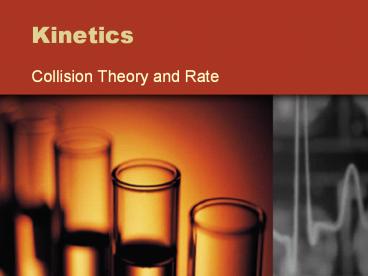Kinetics - PowerPoint PPT Presentation
1 / 17
Title: Kinetics
1
Kinetics
- Collision Theory and Rate
2
Kinetics
- Kinetics is a term that relates to how fast a
reaction occurs - We measure the rate of a car moving in kilometers
per hour or distance per unit time - Similarly we measure the rate of a reaction by
change in concentration per second(M/s) or amount
per unit time
3
Collision Theory
- Collision theory explains how chemical reactions
occur and why rates of reaction differ - For a reaction to occur particles must collide
and with the correct amount of energy and correct
orientation - Only a fraction of collision cause chemical
change - These successful collisions have sufficient
energy upon impact to break the existing bonds
and form new bonds, and are colliding with the
correct orientation resulting in the products of
the reaction
4
Collision Theory-Orientation
- Consider a reaction involving a collision between
two molecules ethene, and hydrogen chloride.
These react to give chloroethane. - The reaction can only happen if the hydrogen end
of the H-Cl bond approaches the carbon-carbon
double bond. Any other collision between the two
molecules doesn't work. The two simply bounce off
each other.
5
Collision Theory-Orientation
6
Collision Theory-activation energy
- The activation energy is the minimum amount of
energy required to initiate a chemical reaction - You can show this on an energy profile for the
reaction. For a simple over-all exothermic
reaction, the energy profile is shown beside
7
Collisions and rate
- We expect the reaction to be directly
proportional to the number of collisions per
second
8
Rate
- Rate
- Appearance of products
- Disappearance of reactants
- For the reaction A B ? C, the rate of the
appearance of C would be written as
?C - ?t
- The rate of disappearance of A and B would be
written as - -?A and -?B
- ?t ?t
Where ? change in and square brackets means
concentration
9
Example
- 2N2O5(g) ? 4NO2(g) O2(g)
- The Rates
- -?N2O5 ? ?NO2 ? ?O2
- ?t ?t ?t
- Correct
- -1 (?N2O5) 1 (?NO2) ?O2
- 2 ?t 4 ?t ?t
10
Rate
- The rate changes throughout the course of the
reaction because the concentrations change
non-linearly over the time of the reaction - Cannot calculate a single number for the rate of
entire reaction - Instead, we calculate an average rate over a
given time interval, or an instantaneous rate at
a given instant in time
11
Rate
- Lets suppose we wanted to know how fast the
reaction below was going at a given time
12
Average rate Equals the slope of the straight
line connecting two points representing the
beginning and end of that chosen time
interval. Instantaneous rate Equals the slope of
the line tangent to the curve at a
particular time
13
- Average rate of H2, for example, is given by
the equation
14
Question
- Determine the relative reaction rates of the
species in the following reaction - 2C2H2(g) 5O2(g) ? 4CO2(g) 2H2O(l)
- 1 (-?C2H2) 1 (-?O2) 1 (-?CO2) 1
?H2O) - ?t ?t ?t
?t
15
Question
- 2A B ? 3C D
- If the rate of disappearance of A at a certain
time is -0.084M/s what is the rate of change of
B? C? D?
16
Answer
- B is half the rate of A so
- Bs rate -0.042M/s
- C and A have a ratio of 32 so
- Cs rate0.126M/s
- D and A have a ratio of 12 so
- Ds rate0.042M/s
17
Rate Constant
- The term k is known as the rate constant
- It is a constant of proportionality between the
reaction rate and the concentration of reactant - k is not affected by the concentration of
reactant - The ratio between rate and reactant always
remains the same(if temp stays constant) - Can use data from any t to calculate the rate
constant for reaction































